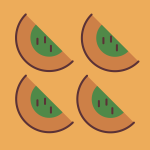Material required
- Hoe (Jembe) or shovel
- Pickaxe (for hard soils)
- String or thin rope
- Pegs or stones
- To measure the contour line, here are some examples of tools that could be used: a string line level or spirit level instrument, hose pipe half filled with water, bottle of water half filled with water, A-frame level.
Steps of Implementation
Bunds are created by using earth or stones and have a diameter from 2 to 8 meters (although they can measure up to 12m). The bund tips are usually placed along a contour line, facing upslope. Bunds are usually 30-50 cm high. They are arranged in alternating patterns so that the line below can catch the runoff coming from the line above, and so on. In dry conditions, a bunds’ diameter is bigger, whereas, in wetter conditions, bunds are usually smaller but more copious.
- Using a simple surveying instrument, stake out the first contour following the contour line.
- With the help of a tape measure, mark the tips of the semi-circular bunds on the contour.
- Mark the center point between the two tips. Then, take a piece of string, as long as the radius of the bund (the distance between one tip and the center), and fix it and hold it in place at the center point with the help of a peg or a big stone. Holding the string tight at the other end, trace the semi-circle, following the path of the tight string from one tip to the other. The semi-circle can be traced with the help of a stick drawing in the soil, or by placing pegs or small stones.

Source
- Repeat the procedure to draw the other bunds, paying attention to respect the desired alternating pattern, making sure that the center point of each bund coincides with the gap between the bunds in the first row (upslope) and so on.
- After you have finished making the design, start the bund construction by excavating a small trench inside each bund, always starting from the inside of the bund. Create layers of 10-15 cm each, compacting and wetting them if possible.
- The bund tips can be reinforced with stones, to ensure more resistance against erosion.
- The construction of a diversion ditch might be required to protect the first row of bunds from water runoff of the above area. One or more diversion ditches can be built if considered necessary. The size of a diversion ditch should be 1-1.5 m wide and 50 cm deep, with a 0.25% gradient.

Source
Other: The space between the bunds can vary according to the purpose. Larger and more widely spaced Demi-lunes are more suitable for grazing land rehabilitation or fodder production. Smaller and closely spaced half-moons fit better for growing trees and shrubs.
Estimation of costs and benefits of intervention
| Establishment cost |
About US $8 per bund, US $150/ha with labor time? |
| Labor time |
>20 person days/ha, 2-8 demi-lunes per person per day |
| Which products |
Trees, sorghum, maize |
(Source)
1. Landscape restoration with demi-lunes in Kenya and Tanzania
Description
The demi-lunes project in Kenya and Tanzania includes 39,060,000 m² of dry land, where over 315,000 earth smiles are being dug. The project is entirely carried out by local partners and communities, which makes them committed and gives them ownership of the project. The major benefits observed by bringing back vegetation are 1)preventing soil erosion, 2) improved quality of soil and water, 3) cooling down of earth locally and 4) cooling down the soil. If you are interested to check thel video material on the project in Tanzania, please click here and here..
2. Semi-circular bunds for crops and forest/rangelands in Niger
Description
The Sahel region in Niger always faces a high degree of climate variability, manifested in unexpected spells during the rainy season and a varied rainfall pattern. The local population is mainly composed of small farmers and livestock keepers. The implementation of semi-circular bunds has helped people in the Sahel to manage their ecosystems more effectively and increase their land productivity. As a result, the local communities are better prepared to cope with environmental changes and the impact of shocks and especially droughts. Paralleled to Niger, an overarching project is ongoing by the UN World Food programme in the Sahel Region in Africa, where in various countries in the region semi-circular bunds are being introduced. The following examples are some of the many that have been happening in the region. For more information on the larger project, please click here. For an example of demi-lunes in Mauritania, please click here.
3. Semi-circular bunds in Kuku, Kenya
Description
A project run by JustDiggit, has dug 360 000 semi-circular bunds in Kuku Group Ranch. The intervention resulted in bringing back vegetation and creating environmental benefits through making the land useful again for the comminity (JustDiggit, 2024). The bunds slow down and capture rainwater running downhills, preventing erosion of fertile soil. The water balance in the soil restores, increasing the water availability for the seeds still present in the soil (JustDiggit, 2024). The project is part of a bigger mission of JustDiggit to regreen the African landscapes, by inspiring, uniting and empowering the new generation of landscape restoration movement.





